Martin Scorsese: The King of Cinema
It’s fair to say that the name Martin Scorsese is synonymous with the modern-day gangster or mob picture genre. His name conjures images of a sharp-suited and silent Robert De Niro in a smoke-filled bar, a psychotic Joe Pesci who wants to know why he’s funny and freshly dug out corn field graves. But out of the 28 dramatic films Scorsese has made throughout his career, only six could be considered as ‘gangster’ films, with nearly as many (five) that have a spiritual or religious central theme. He has made a period drama, a Howard Hughes biopic, documentaries, the sequel to a Hollywood 60s classic, an animated children’s film, surreal comedies and a film about the early life of the Dalai Lama. There really is something for everyone in the Scorsese catalogue.
Born to Charles and Catherine Scorsese in 1942, Marty grew up in Manhattan’s Little Italy district after moving there from Queens. Suffering with asthma as a child, he was unable to play with the other kids in his neighbourhood and was instead taken to the movies by his parents. He quickly fell in love with the art and language of cinema through the Hollywood films of the 40s and 50s, as detailed in the encyclopaedic A PERSONAL JOURNEY WITH MARTIN SCORSESE THROUGH AMERICAN MOVIES (1995). He would go on to get his Bachelor’s degree in English, before gaining his Master’s in film.
Early in his career, Scorsese’s films WHO’S THAT KNOCKING AT MY DOOR? (1967) and MEAN STREETS (1973), both starring Harvey Keitel in the lead role, are driven by central themes of guilt, atonement and the search for redemption. The films take place in the neighbourhoods Scorsese grew up in, they have a strong documentary and improvised feel, being made on small budgets. MEAN STREETS is also notable for being the first Martin Scorsese film lifelong-collaborator, Robert De Niro appears in as the wild and explosive loving Johnny Boy. It would be a creative relationship that would go on to establish both men as masters of their art, yielding some of the most iconic moments in western cinema.
In 1976, Scorsese made TAXI DRIVER. Based on Paul Schrader’s script, it tells the tale of Travis Bickle (Robert De Niro) a man who takes a job as a New York taxi driver because he can’t sleep. Surrounded by a constant stream of people in his cab, De Niro’s Bickle falls further and further into a nightmare world of loneliness, obsession and brooding violence. The film also stars Cybil Shephard, Harvey Keitel and Albert Brooks. A 12-year-old Jodie Foster was controversially cast as child prostitute, Iris with Foster’s nineteen-year-old sister standing in for her during the more explicit scenes. The film’s iconic ‘Are you talking to me?’ scene has transcended the film fan world, becoming an everyday part of pop culture language. But more importantly, the film marks an evolution in Scorsese’s use of the camera. It becomes an extension of Travis Bickle’s growing alienation and paranoia through brilliant use of slow motion, tracking shots and flash zooms that drags the audience down a dark rabbit hole, immersing them in a seedy world, foreshadowing the extreme violence to come. The film was a success both critically and financially, making $28million at the box office. It remains as arresting, desperate and chilling as it was over forty years ago and is the first of several Scorsese films to regularly feature high on many greatest films of all time lists.
Scorsese followed the success of TAXI DRIVER with NEW YORK, NEW YORK (1977), which starred Robert De Niro as big band saxophonist, Jimmy Doyle and Liza Minnelli as singer, Francine Evans. The film begins the day after WWII has ended and follows the tumultuous romance and professional rise of both Jimmy and Francine. The film was a box office failure, despite showcasing Scorsese’s love for the studio musicals of the 40s and 50s. It is now most notable for spawning the Sinatra and Karaoke staple, New York, New York. After the financial failure of the film, Scorsese suffered from depression with increased drug abuse, falling into ill health at the end of the 70s. It would take a hospital visit from De Niro, holding a book about a boxer that he had carried around with him on the set of NEW YORK, NEW YORK to persuade him to make his next feature film.
RAGING BULL (1980), tells the real-life story of boxer Jake La Motta (Robert De Niro). It stars Cathy Moriarty as Vicki La Motta, Jake’s wife and marks the first appearance of Joe Pesci in a Scorsese picture playing Joey La Motta, Jake’s brother and manager. Shot in black and white, the film follows La Motta’s rise to the top in the Boxing world, as well as portraying a man who brutalises those who are closest to him. The fight scenes set within the boxing ring are highly stylized and choreographed, where blood spurts from punctured faces onto the spectators below. Primal animal-like growls undercut flashlights, as roaring crowds baying for blood are glimpsed through the mist. The camera moves like a fighter, choosing its moment to strike with flash cuts, slow motion and balletic tracking. The violence depicted within the ring pales when compared to the brutality of the domestic abuse suffered by Jake’s wife. The stomach-churning cycle of paranoia, anger and violence repeats over and over again in a self-destructive pattern that is all too familiar for far too many people. Mascagni’s beautiful Intermezzo from Cavalleria rusticana only serves to heighten the sense of tragedy and waste. The film won two Academy Awards, Best Actor for De Niro and Best Editing for long-time collaborator, Thelma Schoonmaker. RAGING BULL made a modest profit upon release but has gone one to become a must have for many a film fan’s library and is widely regarded as one of the greatest films ever made.
The final Scorsese / De Niro collaboration for the next nine years was THE KING OF COMEDY (1982). De Niro plays Rupert Pupkin, a man obsessed with stand-up comedy, celebrity talk shows and particularly the host of his favourite talk show, Jerry Langford (Jerry Lewis). Unable to make it onto the show as a guest comic, Rupert enlists the help of his fellow obsessive and friend Masha (Sandra Bernhard). Together they kidnap Jerry and demand Rupert appears on Jerry’s show by way of ransom. The film was a box office flop but has gone on to become a slow-burning cult hit and joins the ranks of Scorsese / De Niro masterpieces. Much like Sidney Lumet’s NETWORK (1976), THE KING OF COMEDY was way ahead of its time in examining our obsession with the media and celebrity. The film was a huge influence on Todd Phillips’s JOKER (2019), which starred Joaquin Phoenix as the stand-up comedy obsessed Arthur Fleck and Robert De Niro as celebrity talk show host Murray Franklin. The similarities are there for all to see.
1985’s AFTER HOURS starring Griffin Dunne, who was best known for playing Jack Goodman, the ever decaying undead friend in John Landis’s AN AMERICAN WEREWOLF IN LONDON (1981), is a surreal and darkly comic journey through the streets and bars of New York on a single night for Dunne’s character, Paul Hackett. Along the way, he encounters many strange characters played by an impressive supporting cast such as Cheech and Chong, Roseanna Arquette, SCHITT’S CREEK’s Catherine O’Hara, John Heard and Teri Garr.
Scorsese followed this with his most audacious film to date. THE COLOR OF MONEY (1986), is the sequel to the 1961 Hollywood classic, Robert Rossen’s THE HUSTLER. Paul Newman returns as Fast Eddie Felson, who is now a liquor salesman. He discovers and goes on the road with cocky, pool-playing wunderkind Vincent (Tom Cruise) and his girlfriend Carmen (Mary Elizabeth Mastrantonio). Newman won Best Actor at The Academy Awards. It was another critical and box office success, grossing $52million. The film displays yet again Scorsese’s mastery of camera movement, exchanging RAGING BULL’s boxing ring for the pool table as Newman’s contemplative stillness contrasts with Cruise’s youthful exuberance and showmanship. Mastrantonio is wonderful as the smarter beyond her years Carmen and received an Academy nomination for Best Actress in a Supporting Role.
In 1988 he released his most controversial film to date, THE LAST TEMPTATION OF CHRIST, which starred Willem Defoe as Jesus, Harvey Keitel as Judas, Barbara Hershey as Mary Magdalene and David Bowie as Pontius Pilate. With a script by TAXI DRIVER’s Paul Schrader, based upon the Nikos Kazantzakis novel, the film presents an alternative account of the life and death of Jesus. It most controversially depicted a scene where Christ is tempted by Satan with the life of a normal family man. The film’s subject matter led to objections and protests by many religious groups. Cinema chains refused to show the film, as did home video outlets upon its release on the video market. It was banned in many countries and some cinemas that did show the film were subjected to protests or even violence during the film’s run. Scorsese received a nomination for Best Director at The Academy Awards. The film was not a financial success, no doubt mainly due to the pressure placed on cinemas that dared show the film in America and the mainly Christian European cinema territories. But it remains a brilliant meditation on the nature of divinity and mortality.
Cementing Scorsese’s place among the greatest film directors of all time, GOODFELLAS (1990) stars Ray Liotta in the lead role as Henry Hill with a supporting cast including Robert De Niro, Joe Pesci, Lorraine Bracco, Paul Sorvino, Frank Vincent and an early appearance by Samuel L Jackson. The adaptation of Nicholas Pileggi’s book Wiseguys is for many the zenith of Scorsese’s catalogue, combining laugh out loud moments of macabre humour with horrific violence, such as ‘the leg or the wing’, Morrie’s adverts or sitting down to dinner with Tommy’s mum (played by Scorsese’s real life mother, Catherine Scorsese) as Billy Batts lies dying in the trunk of Tommy’s car outside. All of Scorsese’s technical bravura is on display, from long and winding one-shot tracking Steadicam scenes, flash zooms, slow motion, and the brilliant use of period popular music that expresses the mood or inner monologue of a character perfectly. Almost universally lauded by critics and nominated for six Academy Awards including Best Picture, it won only one, Best Actor in a Supporting Role for Joe Pesci. Surprisingly the film was not a big success and made only just under $47million gross worldwide but is up there as one of Scorsese’s greatest films.
Box office success was however not far away with CAPE FEAR (1991). It was a remake of the 1962 J Lee Thompson directed classic of the same name, starring Gregory Peck and Robert Mitchum, who would both take up cameo roles in Scorsese’s version. The film stars Robert De Niro as psychotic rapist, Max Cady seeking revenge from Sam Bowden (Nick Nolte), the defence lawyer who threw Cady’s court case years before, leading to his incarceration. The film also boasts Jessica Lange as Leigh Bowden, Sam’s wife and Juliette Lewis as Danielle, their teenage daughter. De Niro is on scene stealing form as the over the top, predatory Cady. The film riffs brilliantly on moments of Hitchcockesque melodrama, with a soaring orchestral score taken from the original Cape Fear score, composed by Bernard Hermann and conducted by Elmer Bernstein. Scorsese uses almost every trick in the book such as forced perspectives, colour washes and a gymnastic, gravity defying camera that makes the audience believe anything is possible. The film grossed $182million worldwide and has earned its place in popular culture, having been immortalised by THE SIMPSONS with Sideshow Bob in the De Niro role.
He then slowed things down with somewhat of a departure in THE AGE OF INNOCENCE (1993), starring Daniel Day-Lewis, Winona Ryder and Michelle Pfeiffer. Based on the Edith Wharton novel set in 1870s New York society, it follows the story of Newland Archer (Day-Lewis), betrothed to May (Ryder) but in love with Ellen (Pfeiffer). The period piece is beautifully shot with now familiar dizzying camera work, colour washes and quick zooms that emphasise and heighten emotion. For many audiences in the 90s, the pace was pedestrian but by modern comparisons the running time of 2 hours 19 minutes is commonplace for dramas such as these.
1995’s CASINO followed with a return to familiar mob story territory, although this time set in the bright lights of Las Vegas. Scorsese regulars, De Niro and Pesci were joined by Sharon Stone who gives a wonderful Oscar-nominated performance as Ginger, the Vegas hustler who always needs an escape route, even in marriage. The film uses many of the same narrative tools as Goodfellas, employing multiple character narration, a myriad of era-appropriate pop songs and classical music to tell a story of a friendship, betrayal and a dizzying rise to power that will almost inevitably crumble into violence and retribution.
His next film, KUNDUN (1997) told the story of the 14th Dalai Lama from early childhood through to his escape from the Chinese Army to live a life in exile. The film used many Buddhist monks in the cast with the Dalai Lama’s great nephew, Tenzin Thutob Tsarong playing him as an adult. The film was not a financial success, with the Disney-owned production company, Touchstone Pictures distancing itself from the film as Disney attempted to enter the Chinese film markets and Scorsese himself was banned from ever entering China-controlled Tibet. But the film has a meditative beauty, with vibrant colours filling the screen, haunting music and almost tableau images that bring to life a world rarely witnessed by western cultures.
In the following years, Scorsese made BRINGING OUT THE DEAD (1999), GANGS OF NEW YORK (2002), his first collaboration with Leonardo DiCaprio, THE AVIATOR (2004), the star studded Howard Hughes biopic and then in 2006 he made THE DEPARTED. A Boston-set remake of the Hong Kong based film, INFERNAL AFFAIRS (2002), it tells the story of an undercover cop infiltrating a top Boston criminal gang and a member of the same criminal gang infiltrating the Boston Police. The heavyweight cast features Leonardo DiCaprio, Matt Damon, Jack Nicholson, Martin Sheen, Vera Farmiga and Alec Baldwin to name just a few. The film won Scorsese his first Best Director Oscar. It touches on familiar themes of loyalty, betrayal and guilt and was a huge financial success, taking over $290million at the box office.
He then went on to make SHUTTER ISLAND (2010), HUGO (2011), THE WOLF OF WALL STREET (2013) and SILENCE (2016).
In 2019, he made his Netflix debut with THE IRISHMAN, the film that finally delivers the kinds of scenes films fans have craved between Robert De Niro and Al Pacino, as well as reuniting Scorsese favourites Joe Pesci and Harvey Keitel. The film’s supporting cast would be more than enough for any other Hollywood film’s leading cast, with Ray Romano, Bobby Cannavale, Anna Paquin, Stephen Graham and Jesse Plemons. It follows the life of Teamster Union and Mob enforcer, Frank Sheeran (De Niro) as he looks back on his life from his retirement home wheelchair and his friendship with Teamster Union boss Jimmy Hoffa (Pacino) and underworld boss Russell Bufalino (Pesci). More than any other of Scorsese’s pictures, THE IRISHMAN deals with regrets from the perspective of a life lived and nearing its end. For some, the use of ‘de-aging’ cgi effects on De Niro, Pesci and Pacino was distracting. But there is no denying with so many legendary actors on show in one film, they all brought their A-game to the movie. Pesci is terrifying as the still and quiet mob boss, De Niro is back on brutal and explosive form and Pacino is perfectly cast as the egotistical showman and ‘man of the people’, Hoffa. The one thing that is lacking is Scorsese’s kinetic camera work which was inhibited from having to use a three camera set-up on most shots in order for the de-aging process to succeed. But aside from this, the film is as satisfying as almost any of his prior works and featured heavily in last year’s Academy Awards with 10 nominations.
His next film is due to be an adaptation of the David Grann book, KILLERS OF THE FLOWER MOON, which will star both Scorsese muses and collaborators, De Niro and DeCaprio and will certainly be an exciting prospect to look forward to.
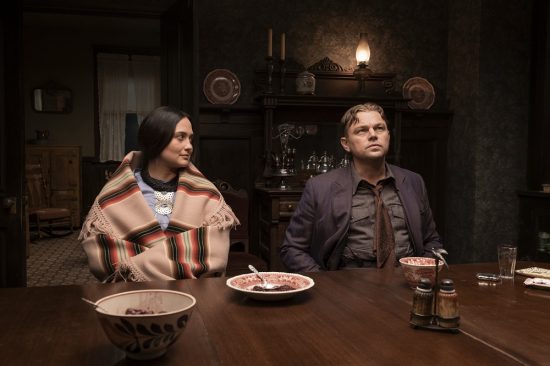
Leonardo DiCaprio and Lily Gladstone in a scene from Martin Scorsese’s highly anticipated upcoming Apple Original Film, “Killers of the Flower Moon.” Gray Horse, Oklahoma 1919. DiCaprio plays Ernest Burkhart, and Gladstone appears as Mollie Burkhart, an Osage woman who falls in love with Ernest. Early in their relationship, Mollie invites him in for a meal and they form a bond. (Credit: Courtesy of Apple)
Martin Scorsese has often faced criticism for making male-dominated films, and to a certain extent, there is merit in that line of criticism. But when his body of work is examined more closely, the women in his films play not only pivotal roles who may suffer at the hands of men, but they are in no way generic victim characters. In TAXI DRIVER Cybil Shepherd and Jodie Foster both play very strong and intelligent women at different stages in their lives. Shepherd’s Betsy rightfully rejects Bickle’s ill-conceived advances and Foster’s Iris, is a child trying to strike out on her own and in an attempt at achieving independence has unwittingly been exploited by the evil Sport (Keitel). Cathy Moriarty’s Vickie La Motta in RAGING BULL marries the abusive Jake La Motta, but survives the relentless domestic abuse to escape and forge her own life with her children. Mary Elizabeth Mastrantonio’s Carmen in THE COLOR OF MONEY is arguably the most intelligent and cunning character out of the three protagonists, playing both Newman’s Fast Eddie and Cruise’s Vincent perfectly in order for her to get exactly what she wants from the pair of them. It is May (Ryder) and Ellen (Pfeiffer) in THE AGE OF INNOCENCE that ultimately know Daniel Day-Lewis’s Newland Archer better than he does himself. Margot Robbie’s Naomi in THE WOLF OF WALL STREET knows exactly when to jump ship as DeCaprio’s Jordan Belfort implodes in a self-indulgent and narcissistic drug fuelled haze, and Anna Paquin is haunting in THE IRISHMAN as Sheeran’s daughter who witnesses her father’s brutality first hand and never forgets it. For the majority of the film, her silence crushes and reduces a man of violence and power to a shadow of regret and guilt.
The films of Scorsese have not only entertained, shocked and thrilled over the years but have also held a mirror up to our darkest inner thoughts and fears. His work touches on primal needs for atonement and redemption, not only examining the human condition through filters of guilt, anger, regret and violence but also celebrates the nature of friendships, faith, spirituality and lifelong bonds. He has become an undisputed master in the art of film and enriches our imaginations with the simple yet powerful combination of an image with sound. Martin Scorsese is with no doubt The King of Cinema.

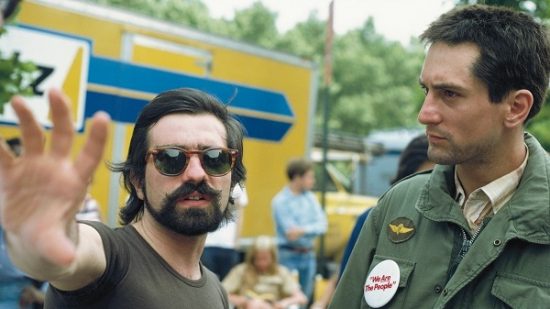
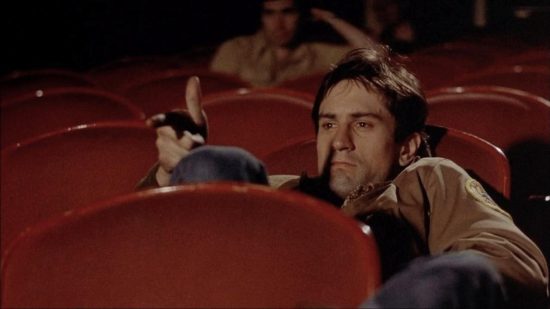
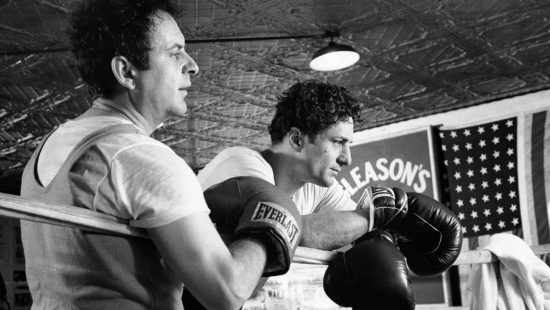
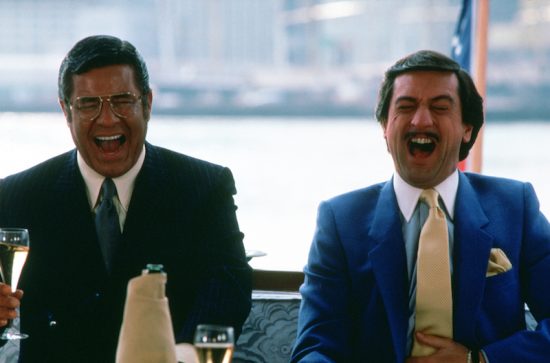
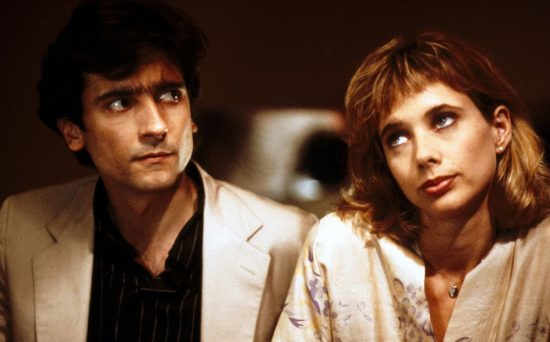
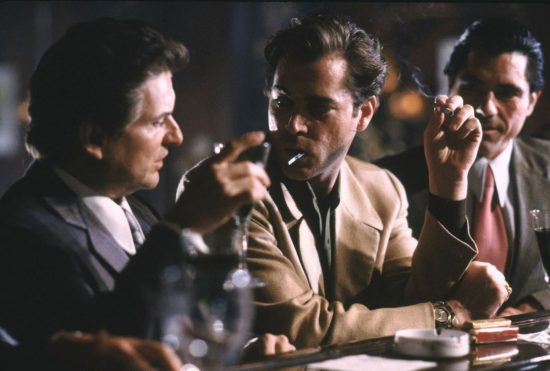
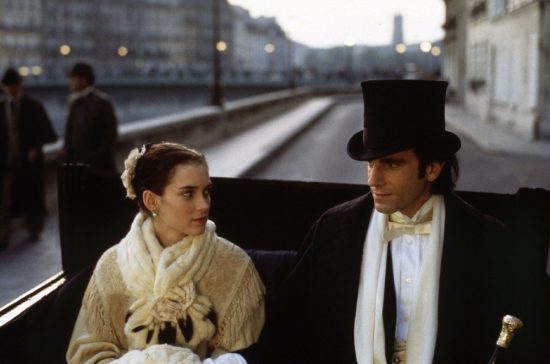
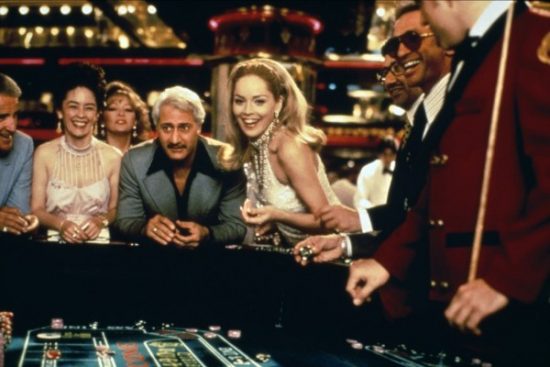
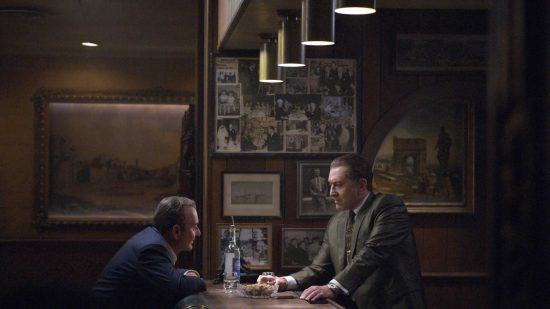
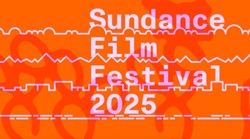








Uh, no-one cares fat man